
Pyrrharctia isabella, the isabella tiger moth, whose larval form is called the banded woolly bear, woolly bear, or woolly worm, occurs in the United States and southern Canada. It was first formally named by James Edward Smith in 1797.

The beet armyworm or small mottled willow moth is one of the best-known agricultural pest insects. It is also known as the asparagus fern caterpillar. It is native to Asia, but has been introduced worldwide and is now found almost anywhere its many host crops are grown. The voracious larvae are the main culprits. In the British Isles, where it is an introduced species and not known to breed, the adult moth is known as the small mottled willow moth.

Halysidota tessellaris, also called the pale tiger moth, banded tussock moth, and tessellated halisidota, is in the family Erebidae and the tribe Arctiini, the tiger moths. The species was first described by James Edward Smith in 1797. Like many related species, adult moths have chemical defenses acquired from its host plants, in this case, alkaloids. Larval behaviors suggest that they are chemically protected; they have not been analyzed for alkaloid content.

Biston strataria, the oak beauty, is a moth of the family Geometridae. It is native to Europe, the Balkan countries and the Black Sea region as far as Asia Minor and the Caucasus. The species was first described by Johann Siegfried Hufnagel in 1767. B. strataria is found in a variety of habitats, but is mostly found in woodlands where it rests on the bark of trees, camouflaged by its mottled black and grey wings. The male has feather-like antennae while those of the female are more thread-like. The moth has a wingspan of 40 to 56 mm.

The Broom Moth(Ceramica pisi) is a moth of the family Noctuidae. It is found in all of Europe, East across the Palearctic to Siberia and the Russian Far East. In the north, it is found far beyond the Arctic Circle and in the South to North Spain. In the Alps, it is found up to heights of up to 2,000 metres.

Diloba caeruleocephala, the figure of eight, is a moth of the family Noctuidae. It is found in the Palearctic.

Euxoa obelisca, the square-spot dart, is a moth of the family Noctuidae. It is found in the Palearctic realm.

Xestia baja, the dotted clay, is a species of moth of the family Noctuidae. It is found in Europe, Turkey, northern Iran, Transcaucasia, the Caucasus, central Asia, Siberia, Mongolia, Tibet, China, Korea and Japan.
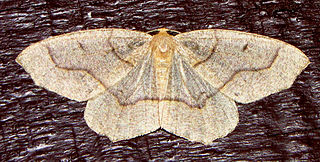
Lambdina fiscellaria, the mournful thorn or hemlock looper, is a moth of the family Geometridae. It is found in North America, from the Pacific to the Atlantic coast and from Canada south to Pennsylvania, Wisconsin and California.

Agrotis cinerea, the light feathered rustic, is a moth of the family Noctuidae. The species was first described by Michael Denis and Ignaz Schiffermüller in 1775. It is found in southern and central Europe, northern Turkey, the Caucasus, western Turkmenia and Central Asia.

Sasunaga tenebrosa is a moth of the family Noctuidae first described by Frederic Moore in 1867. It is found from the Indian subregion, Sri Lanka to Sundaland, the Philippines and Sulawesi.
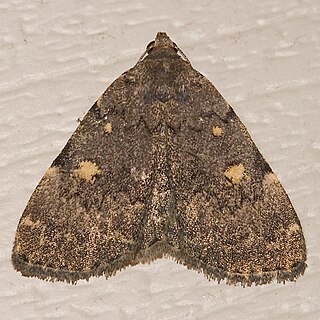
Idia aemula, the common idia, powdered snout or waved tabby, is a litter moth of the family Erebidae. The species was first described by Jacob Hübner in 1813. It is found from Canada south to Florida and Texas. It has been reported in the Palearctic.
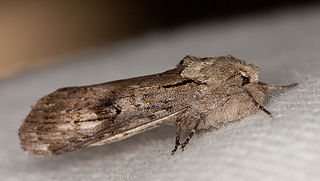
Schizura is a genus of moths of the family Notodontidae first described by Edward Doubleday in 1841.
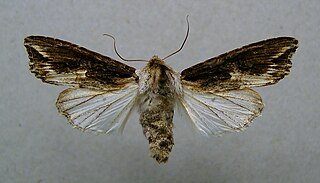
Egira conspicillaris, the silver cloud, is a moth of the family Noctuidae. The species was first described by Carl Linnaeus in his 1758 10th edition of Systema Naturae. It is found from the Iberian Peninsula to Russia. In the north it ranges to the Baltic Region and in the south to North Africa. It is also present in the Near East, up to the Caspian Sea.
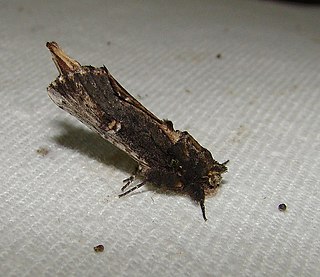
Schizura ipomoeae, the morning-glory prominent moth or false unicorn caterpillar, is a moth of the family Notodontidae. The species was first described by Edward Doubleday in 1841. It is found in the United States and southern Canada.
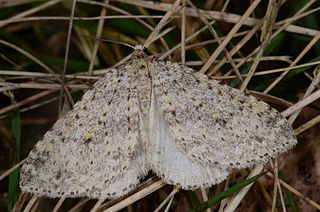
Colostygia multistrigaria, the mottled grey, is a species of moth in the family Geometridae. It is found in western and south-western Europe and North Africa.The habitat is damp woodlands, heaths, and mosses.

Parastichtis suspecta, the suspected, is a species of moth in the family Noctuidae. It is found from most of Europe through Russia and east through the Palearctic to Japan. It is also found in North America.

Phaeoura quernaria, the oak beauty, is a moth of the family Geometridae. The species was first described by James Edward Smith in 1797. It is found in eastern North America, occurring as far west as east-central Alberta. The habitat consists of aspen-cherry shrubland.

Ichneutica maya is a moth of the family Noctuidae. It is endemic to New Zealand. It is found in the mountains in southern half of the North Island and in the South Island. I. maya is a distinctively coloured and patterned moth and as such is unlikely to be confused with similar species. I. maya can be found in the southern half of the North Island down through the South Island. This species can be found in alpine to subalpine zones with high rainfall but in Southland this species can be found down to sea level. This life history in the wild is unknown, nor has its larval host species been confirmed. Adults are on the wing from December to March and are attracted to sugar and light traps.

Sympistis chionanthi, the grey o moth or fringe-tree sallow, is a moth of the family Noctuidae. The species was first described by James Edward Smith in 1797. It is found from North Dakota to Nova Scotia south to at least to Virginia and Kansas. The habitat consists of deciduous woodlands, including riparian woodlands, but also plantations and farmyard shelterbelts.





















